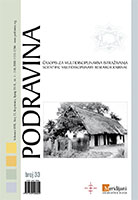- ARENDA – NASELJE KASNOG BRONČANOG DOBA I PROBLEMATIKA NASEOBINSKIH OBRAZACA U DRAVSKOJ NIZINI
- THE GEOLOGICAL HISTORY OF THE RIVER DRAVA IN CARINTHIA (AUSTRIA) – KNOWN FACTS AND PROJECT DESCRIPTION
- THE ECONOMIC ROLE OF THE DRAVA RIVER IN SLOVENIA: FROM NAVIGATION TO HYDROPOWER
- DETERMINING ACCESSIBILITY OF POST NETWORK ELEMENTS WITH APPLICATION OF GRAVITY METHOD
- PRIJEDLOG I SIMULACIJSKA ANALIZA MJERA ZA UNAPREĐENJE ŽELJEZNIČKOG PUTNIČKOG PROMETA NA RELACIJI KOPRIVNICA – VIROVITICA
- A FORGOTTEN SIEGE: MIKLÓS ZRÍNYI’S 1557 ATTACK ON ČAZMA
- THE STATUE OF SAINT JOHN OF NEPOMUK FROM THE SLIVNICA MANSION PARK – OVERLOOKED WORK OF JOSEPH STRAUB
- DEMOGRAFSKI POKAZATELJI U MATIČNIM KNJIGAMA UMRLIH ZA NASELJA UZ KOPAČKI RIT U 18. I PRVOJ POLOVICI 19. STOLJEĆA
- ZARAZNE BOLESTI I SMRTNOST DJECE U ŽUPI ĐURĐEVAC OD 1912. DO 1918. GODINE NA TEMELJU MATIČNIH KNJIGA UMRLIH
- POGINULI I UMRLI VOJNICI U VELIKOME RATU S PODRUČJA RKT. ŽUPE U KLOŠTRU PODRAVSKOME
- MAĐARI U KOPRIVNIČKO-KRIŽEVAČKOJ ŽUPANIJI: SVAKODNEVICA, SJEĆANJE/PAMĆENJE I NACIONALNI IDENTITET
- DVIJE DONJODUBRAVSKE RUKOPISNE PJESMARICE IZ PERA MATIJE FELETARA
- PRIKAZI NOVIH KNJIGA, ČASOPISA I ZNANSTVENIH SKUPOVA
- UPUTE SURADNICIMA
THE ECONOMIC ROLE OF THE DRAVA RIVER IN SLOVENIA: FROM NAVIGATION TO HYDROPOWER
The Drava River has an alpine snow-rain discharge regime with a spring and fall maximum flow and a summer and winter minimum flow. For people it represented a natural border, was a source of drinking water and food, and served as an important transport route. Timber floating has been attested since the thirteenth century. In the first half of the twentieth century, up to 100,000 m3 of timber was annually floated on the river. With the arrival of the railroad in the mid- to late nineteenth century, the Drava lost some of its transport function, but it nonetheless remained the most important timber transport route until the Second World War. The gradual construction of as many as eight hydroelectric plants in the twentieth century completely changed the role of the river in Slovenia. Although this corresponded to the final end of timber floating and also the gradual loss of its other transport functions, the demands for labor to build the hydroelectric infrastructure prevented large-scale out-migration from the area. Many people also found employment in the newly established factories. Today the area along the Drava has both a cultural role (e.g., the Lent Festival in Maribor and the preservation of the timber floating tradition) and a recreational one (e.g., hiking and water sports). Throughout history, the river has played an important role in attracting people and maintaining settlement, and it has also anchored itself as a distinct symbol in the cultural and spatial identity of the local population.
Izvorni znanstveni rad / Original scientific paperMatija ZORN

